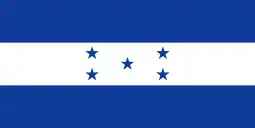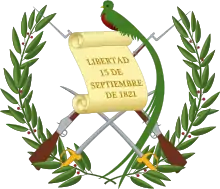Federal Republic of Central America
The Federal Republic of Central America (Spanish: República Federal de Centroamérica), also called the United Provinces of Central America (Provincias Unidas del Centro de América) in its first year of creation, was a sovereign state in Central America that consisted of the territories of the former Captaincy General of Guatemala of New Spain. It existed from July 1823 to February 1841, as a republican democracy.
Federal Republic of Central America República Federal de Centroamérica | |||||||||||||||||||||||
|---|---|---|---|---|---|---|---|---|---|---|---|---|---|---|---|---|---|---|---|---|---|---|---|
| 1823–1841 | |||||||||||||||||||||||
 Flag
 Coat of arms
| |||||||||||||||||||||||
.svg.png.webp) | |||||||||||||||||||||||
| Capital |
| ||||||||||||||||||||||
| Recognised national languages | Spanish | ||||||||||||||||||||||
| Religion | Catholicism | ||||||||||||||||||||||
| Government | Revolutionary republic | ||||||||||||||||||||||
| History | |||||||||||||||||||||||
• Independence from Spanish Empire | September 15, 1821 | ||||||||||||||||||||||
• Independence from First Mexican Empire | July 1, 1823 | ||||||||||||||||||||||
• Disestablished | February 1841 | ||||||||||||||||||||||
| Currency | Central American Republic real | ||||||||||||||||||||||
| |||||||||||||||||||||||


The republic consisted of the present-day Central American countries of Costa Rica, El Salvador, Guatemala, Honduras, and Nicaragua, and the southern Mexican state of Chiapas.[2] In the 1830s, a sixth state was added – Los Altos, with its capital in Quetzaltenango – occupying parts of what are now the western highlands of Guatemala and Chiapas.
Shortly after Central America declared independence from the Spanish Empire in 1821, some of its countries were annexed by the First Mexican Empire in 1822 and then Central America formed the Federal Republic in 1823. From 1838 to 1840, the federation descended into civil war, with conservatives fighting against liberals and separatists fighting to secede. These factions were unable to overcome their ideological differences and the federation was dissolved after a series of bloody conflicts.[3]
History
Independence 1821–1822
From the 16th century through 1821, Central America, apart from Panama, formed the Captaincy General of Guatemala within the Spanish Empire. In 1821 a congress of Central American Criollos in Guatemala City composed the Act of Independence of Central America to declare the region's independence from Spain, effective on September 15 of that year.[4] The process was bloodless with no resistance from the Spanish authorities as the Governor General Brigadier Gabino Gaínza, along with all the royal governors of the five provinces, were retained in office as executive powers pending a full transition to local rule. That date is still marked as independence day by most Central American nations.
Absorption into the Empire of Mexico, 1822–1823
Independence proved short-lived, as local law and order broke down. Driven by regional rivalries, many localities refused to accept the newly formed federal powers in Guatemala—San Salvador, Comayagua, León, and Cartago were in open revolt. On January 25, 1822, the Junta consultiva in Guatemala City voted for annexation. A few weeks later General Vicente Filísola, the envoy of Emperor Agustín de Iturbide of the First Mexican Empire, arrived in Guatemala as the new ruler.[5]
The annexation was controversial, with some seeing the Mexican constitution with its abolition of slavery and establishment of free trade as an improvement over the status quo. Central American liberals in San Salvador objected to this and refused to accept Filísola's authority. The Mexican army was ordered to quell dissent.
In the case of Costa Rica, the country decided not to join the Mexican Empire as part of the resolutions upon conclusion of the Ochomogo War (April 5, 1823), where imperialists lost against Republicans in the first civil war of Costa Rica.
After Iturbide abdicated (March 19, 1823), Mexico became a republic (formally proclaimed on November 1, 1823) and offered the previously annexed Central American provinces the right to determine their own destiny. Filísola turned over his power to the hastily formed National Constituent Assembly, which comprised representatives from each of the five provinces. On July 1, 1823, the Congress of Central America declared absolute independence from Spain, Mexico, and any other foreign nation, and established a republican system of government.[5]
Reconstitution of the Federal Republic 1823–1840
The liberal-dominated Assembly elected Manuel José Arce as president but he soon turned against his own faction and dissolved the Assembly. San Salvador rose in revolt against federal authority. Honduras and Nicaragua joined the rebellion and Arce was deposed in 1829. The victors led by the Honduran Francisco Morazán took power and Morazán was proclaimed president in 1830. To appease liberal supporters, the capital was relocated from Guatemala City to San Salvador in 1831 but as Morazán's hold on power was waning the opposition regained control in the provinces.[5]
The Assembly in 1838 adjourned with the declaration that the provinces were free to rule themselves as the Federal Republic dissolved. In 1839 Morazán was exiled as rebels from Guatemala, Honduras and Nicaragua entered San Salvador, evicting the governing institutions that held the region together.[5]
Dissolution of the union
In practice, the Federation faced insurmountable problems, and the union slid into civil war between 1838 and 1840.[6] Its disintegration began when Nicaragua separated from the federation on November 5, 1838, followed by Honduras and Costa Rica[7] (other sources give Nicaragua's secession date as April 30).[8] Because of the chaotic nature of this period an exact date of disestablishment does not exist, but on May 31, 1838, the Congress met to declare that the provinces were free to create their own independent republics.[8] In reality, this merely legally acknowledged the process of disintegration that had already begun.[9] The union effectively ended in 1840, by which time four of its five states had declared independence. The official end came only upon El Salvador's self-proclamation of the establishment of an independent republic in February 1841.
Name and emblems
.jpg.webp)
The flag shows a white band between two blue stripes, representing the land between two oceans. The coat of arms shows five mountains (one for each state) between two oceans, surmounted by a Phrygian cap, the emblem of the French Revolution. The flag was introduced to the area by Commodore Louis-Michel Aury and inspired by the Argentine flag. The nation also adopted the term "united provinces", used in Argentina's original name, Provincias Unidas del Río de la Plata ("United Provinces of the River Plate").
Successor flags
Today, all five successor nations' flags retain the old federal motif of two outer blue bands bounding an inner white stripe. (Costa Rica modified its flag significantly in 1848, darkening the blue and adding a double-wide inner red band.) The short-lived sixth state of Los Altos was annexed by Mexico as the state of Chiapas.
 |
.svg.png.webp) |
.svg.png.webp) |
.svg.png.webp) |
.svg.png.webp) |
.svg.png.webp) |
 |
| Guatemala | El Salvador | Honduras | Nicaragua | Costa Rica | Los Altos |
 |
 |
 |
 |
 |
 |
| Guatemala | El Salvador | Honduras | Nicaragua | Costa Rica | Chiapas |
Later Central American federal unions
Despite the failure of a lasting political union, the sense of shared history and the hope for eventual reunification persist in the nations formerly in the union. Various attempts were made to reunite Central America in the nineteenth and early twentieth centuries, but none succeeded for any length of time:
- The first attempt was in 1844 by former President Francisco Morazán, who became involved in a struggle for control over Costa Rica. After taking control over the capital, Morazán announced he would create a large army to re-create the Federal Republic as the Confederation of Central America and planned to include El Salvador, Guatemala, Honduras, and Nicaragua, but popular feeling rapidly turned against him and a sudden revolt resulted in his arrest and execution by firing squad on September 15 of that year.
- A second attempt was made in October 1852 when El Salvador, Honduras and Nicaragua created a Federation of Central America (Federación de Centro América). The union lasted less than a month.
- In 1856–1857 the region successfully established a military coalition to repel an invasion by the U.S. freebooter William Walker.
- Guatemalan President General Justo Rufino Barrios attempted to reunite the nation by force of arms in the 1880s but he died in battle near the town of Chalchuapa, El Salvador.
- A third union of Honduras, Nicaragua, and El Salvador as the Greater Republic of Central America (República Mayor de Centroamérica) lasted from 1896 to 1898.
- The latest attempt occurred between June 1921 and January 1922, when El Salvador, Guatemala, Honduras and Costa Rica formed a (second) Federation of Central America. The treaty establishing this federation was signed at San José, Costa Rica, on January 19, 1921.[10] The treaty stipulated for the future creation of one state of all the four signatories, under one constitution. This second federation was nearly moribund from the start, having only a Provisional Federal Council of delegates from each state.
See also
- Gran Colombia – another short-lived post-Spanish federal state
- Peru–Bolivian Confederation – another short-lived post-Spanish federal state
- Golden Circle (proposed country) – a proposed Caribbean federation
- Union of South American Nations, an organization
- Central American Integration System
- Central America-4 Border Control Agreement
References
- Cuhaj, George S., ed. (2009). Standard Catalog of World Gold Coins 1601–Present (6 ed.). Krause. p. 224. ISBN 978-1-4402-0424-1.
- Mandujano, Isaín (June 26, 2001). "Mexico's Southern Border: a Virtual Line".
- Foster, Lynn V. (2000). A Brief History of Central America. New York: Facts on File. pp. 134–136. ISBN 0-8160-3962-3.
- "Documentos de la Union Centroamericana" (PDF). Organization of American States – Foreign Trade Information System. Retrieved October 12, 2014.
- Munro, Dana. The Five Republics of Central America. New York: Oxford University Press, 1918. pp 24–34.
- "New Physical, Political, Industrial and Commercial Map of Central America and the Antilles: With a Special Map of the Possessions of the Belgian Colonization Company of Central America, the State of Guatemala". World Digital Library. 1845. Retrieved July 4, 2013.
- Minster, Christopher. "The Federal Republic of Central America (1823–1840)". Latin American History. About.com. Retrieved November 5, 2013.
- Sandoval, Victor Hugo. "Federal Republic of Central America". Monedas de Guatemala. Retrieved November 5, 2013.
- Karnes, Thomas L. (1961). The Failure of Union: Central America, 1824–1960. Durham, NC: University of North Carolina Press. p. 85.
- Text in League of Nations Treaty Series, vol. 5, pp. 10–31.
